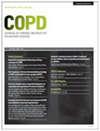Usefulness of Glucose to Lymphocyte Ratio to Predict in-Hospital Mortality in Patients with AECOPD Admitted to the Intensive Care Unit
IF 2.2
4区 医学
Q3 RESPIRATORY SYSTEM
COPD: Journal of Chronic Obstructive Pulmonary Disease
Pub Date : 2022-04-07
DOI:10.1080/15412555.2022.2052272
引用次数: 4
Abstract
Abstract The purpose of this study was to investigate the relationship between glucose to lymphocyte ratio (GLR) and the outcome of acute exacerbation chronic obstructive pulmonary disease (AECOPD) patients admitted to the intensive care unit (ICU). This study included 3573 patients from the eICU Collaborative Research Database (eICU-CRD) and 926 AECOPD patients admitted to ICU from the Medical Information Mart for Intensive Care-IV (MIMIC-IV) database. The optimal cutoff value for GLR was 5.6. Kaplan-Meier analysis demonstrated that patients in lower GLR (< 5.6) group showed a better overall survival than patients in higher GLR (≥ 5.6) group in all sets. Multivariate Cox regression analysis demonstrated that age, Sequential Organ Failure Assessment (SOFA) score, SpO2, albumin and GLR are independent predictors of poor overall survival in the training cohort and were incorporated into the nomogram for in-hospital mortality as independent factors. The nomogram exhibited excellent discrimination with C-indexes in training cohort, internal validation and external validation cohort were (0.801, 95%CI: 0.769-0.863), (0.805, 95%CI: 0.759-0.851) and (0.811, 95%CI: 0.772-0.850), respectively. The calibration plot indicated an adequate fit of the nomogram for predicting the risk of in-hospital mortality in all sets. Moreover, the ROC analyses demonstrated that the discrimination abilities of GLR were better than other blood-based inflammatory biomarkers. As an easily available biomarker, GLR can independently predict the in-hospital mortality in AECOPD patients admitted to ICU. The nomogram combining GLR with other significant indicators exhibited excellence predictive performance for in-hospital mortality.葡萄糖与淋巴细胞比值预测重症监护病房AECOPD患者住院死亡率的有效性
摘要本研究旨在探讨急性加重期慢性阻塞性肺疾病(AECOPD)重症监护病房(ICU)患者血糖与淋巴细胞比值(GLR)与预后的关系。本研究纳入了来自eICU合作研究数据库(eICU- crd)的3573例患者和来自重症监护医学信息市场- iv (MIMIC-IV)数据库的926例AECOPD患者。GLR的最佳临界值为5.6。Kaplan-Meier分析显示,各组低GLR组(< 5.6)患者的总生存期均优于高GLR组(≥5.6)患者。多因素Cox回归分析显示,年龄、顺序器官衰竭评估(SOFA)评分、SpO2、白蛋白和GLR是培训队列中总生存率差的独立预测因子,并作为独立因素纳入住院死亡率的nomogram。训练组、内部验证组和外部验证组的c -指数分别为(0.801,95%CI: 0.769 ~ 0.863)、(0.805,95%CI: 0.759 ~ 0.851)和(0.811,95%CI: 0.772 ~ 0.850)。校正图显示,所有组的nomogram (nomogram)在预测院内死亡风险方面具有足够的拟合性。此外,ROC分析表明,GLR的识别能力优于其他基于血液的炎症生物标志物。GLR作为一种容易获得的生物标志物,可以独立预测ICU AECOPD患者的住院死亡率。结合GLR与其他重要指标的nomogram对院内死亡率的预测表现优异。
本文章由计算机程序翻译,如有差异,请以英文原文为准。
求助全文
约1分钟内获得全文
求助全文
来源期刊

COPD: Journal of Chronic Obstructive Pulmonary Disease
RESPIRATORY SYSTEM-
CiteScore
4.40
自引率
0.00%
发文量
38
审稿时长
6-12 weeks
期刊介绍:
From pathophysiology and cell biology to pharmacology and psychosocial impact, COPD: Journal Of Chronic Obstructive Pulmonary Disease publishes a wide range of original research, reviews, case studies, and conference proceedings to promote advances in the pathophysiology, diagnosis, management, and control of lung and airway disease and inflammation - providing a unique forum for the discussion, design, and evaluation of more efficient and effective strategies in patient care.
 求助内容:
求助内容: 应助结果提醒方式:
应助结果提醒方式:


